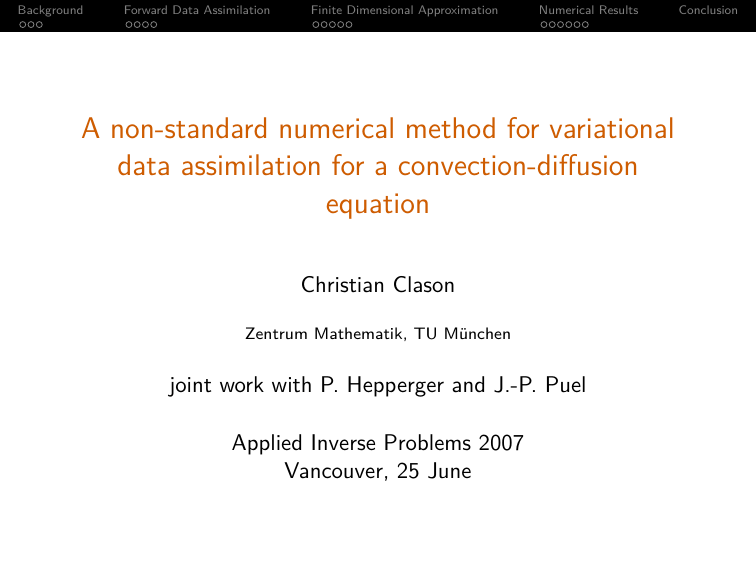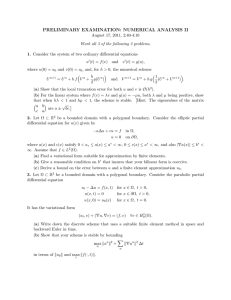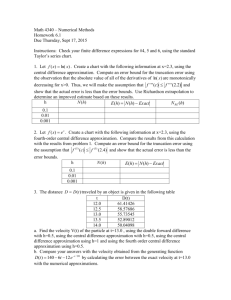A non-standard numerical method for variational data assimilation
advertisement

Background
Forward Data Assimilation
Finite Dimensional Approximation
Numerical Results
A non-standard numerical method for variational
data assimilation for a convection-diffusion
equation
Christian Clason
Zentrum Mathematik, TU München
joint work with P. Hepperger and J.-P. Puel
Applied Inverse Problems 2007
Vancouver, 25 June
Conclusion
Background
Forward Data Assimilation
Finite Dimensional Approximation
1 Background
Motivation
Forward Data Assimilation
2 Forward Data Assimilation
Problem Formulation
Well-posedness
Reconstruction Method
3 Finite Dimensional Approximation
Proper Orthogonal Decomposition
POD Reconstruction Algorithm
4 Numerical Results
5 Conclusion
Numerical Results
Conclusion
Background
Forward Data Assimilation
Finite Dimensional Approximation
Numerical Results
Data Assimilation
Given
• Parabolic state equation (with boundary conditions)
Yt + AY = F
• Distributed measurements Y on (subset) ω
Find
Initial conditions Y0 , s. t. solution Y of IBVP satisfies Y|ω = Y
Ill-posed problem!
Conclusion
Background
Forward Data Assimilation
Finite Dimensional Approximation
Numerical Results
Applications
Application
Weather prediction (Navier-Stokes), Geophysics (Boussinesq)
1
Given observations in [0, T0 ], compute initial state Y0
(assimilation)
2
Solve IBVP in [0, T1 ], T1 > T0
(prediction)
Current methods
Tikhonov-regularised optimal control (4DVAR)
Statistical methods (Ensemble Kalman filter)
Conclusion
Background
Forward Data Assimilation
Finite Dimensional Approximation
Numerical Results
Forward Data Assimilation
Idea
1
Given observations in [0, T0 ], compute final state YT0
(assimilation)
2
Solve IBVP in [T0 , T1 ]
(prediction)
⇒ Replace
• ill-posed control problem for state equation
with
• well-posed control problem for adjoint equation
Conclusion
Background
Forward Data Assimilation
Finite Dimensional Approximation
Numerical Results
Problem Formulation
Ω ⊂ Rn domain, boundary Γ, c : Ω → R, b : Ω × [0, T ] → Rn
Convection-Diffusion equation
(
yt − c 2 ∆y + b T ∇y = f ,
y = 0,
Ω × [0, T ]
Γ × [0, T ]
ω ⊂ Ω nonempty: Given y |ω (x , t), find y (T )!
Adjoint equation
2
−ϕt − c ∆ϕ − div(bϕ) = v χω ,
ϕ = 0,
ϕ(x , T ) = ϕ (x ),
T
Ω × [0, T ]
Γ × [0, T ]
x ∈Ω
χω characteristic function of ω ⊂ Ω, control v : Ω × [0, T ] → R
Conclusion
Background
Forward Data Assimilation
Finite Dimensional Approximation
Numerical Results
Problem Formulation
Ω ⊂ Rn domain, boundary Γ, c : Ω → R, b : Ω × [0, T ] → Rn
Convection-Diffusion equation
(
yt − c 2 ∆y + b T ∇y = f ,
y = 0,
Ω × [0, T ]
Γ × [0, T ]
ω ⊂ Ω nonempty: Given y |ω (x , t), find y (T )!
Adjoint equation
2
−ϕt − c ∆ϕ − div(bϕ) = v χω ,
ϕ = 0,
ϕ(x , T ) = ϕ (x ),
T
Ω × [0, T ]
Γ × [0, T ]
x ∈Ω
χω characteristic function of ω ⊂ Ω, control v : Ω × [0, T ] → R
Conclusion
Background
Forward Data Assimilation
Finite Dimensional Approximation
Numerical Results
Conclusion
Well-posedness
Theorem (Puel 2002)
Γ class C 2 , f ∈ L2 (0, T ; L2 (Ω)), c ∈ C 1 (Ω̄), b ∈ L2 (0, T ; H 1 (Ω)n )
Then: For all T > 0, ω ⊂ Ω nonempty, for any ϕT ∈ L2 (Ω)
• there exists v = v (ϕT ) ∈ L2 (0, T ; L2 (Ω)), s. t. solution of
adjoint equation satisfies:
ϕ(0) = 0
• there exists C (Ω, ω, T ) > 0:
ky (T )kL2 (Ω) ≤ C
Z TZ
0
ω
|y |2 dxdt +
Z TZ
0
!
|f |2 dxdt
Ω
Proof relies on Carleman estimate for 2nd order parabolic equation
Background
Forward Data Assimilation
Finite Dimensional Approximation
Numerical Results
Reconstruction Method
Under conditions of last theorem, the following identity holds:
Z TZ
Z
Ω
y (T )ϕT dx =
0
f ϕ dxdt −
Ω
Z TZ
0
ω
yv (ϕT ) dxdt
for all ϕT ∈ L2 (Ω) with null controlled (by v ) adjoint solution ϕ
⇒ Reconstruction method for y (T ):
Algorithm
Given measurement y |ω , Hilbert basis {ϕn } of L2 (Ω):
1
Calculate null controls v (ϕn ), adjoint solution ϕ
2
Calculate coefficients cn := hy (T ), ϕn iL2 (Ω)
3
Then: y (T ) =
P
n cn ϕn
Conclusion
Background
Forward Data Assimilation
Finite Dimensional Approximation
Numerical Results
Reconstruction Method
Under conditions of last theorem, the following identity holds:
Z TZ
Z
Ω
y (T )ϕT dx =
0
f ϕ dxdt −
Ω
Z TZ
0
ω
yv (ϕT ) dxdt
for all ϕT ∈ L2 (Ω) with null controlled (by v ) adjoint solution ϕ
⇒ Reconstruction method for y (T ):
Algorithm
Given measurement y |ω , Hilbert basis {ϕn } of L2 (Ω):
1
Calculate null controls v (ϕn ), adjoint solution ϕ
2
Calculate coefficients cn := hy (T ), ϕn iL2 (Ω)
3
Then: y (T ) =
P
n cn ϕn
Conclusion
Background
Forward Data Assimilation
Finite Dimensional Approximation
Numerical Results
Conclusion
Exact Distributed Control: Glowinski/Lions
Biadjoint equation
2
T
ψt − c ∆ψ + b ∇ψ = 0,
ψ = 0,
ψ(0) = ψ ,
0
Ω × [0, T ]
Γ × [0, T ]
Ω
Let ϕ(0; v ) solution of adjoint equation controlled by v at t = 0
Operator formulation
Λ : ψ0 7→ ϕ(0; ψ(x , T − t)χω )
Then: Solution ψ0∗ of Λψ0 = 0 yields null control v (ϕT ) := ψ ∗ χω
⇒ Use CG method to compute ψ0∗
Background
Forward Data Assimilation
Finite Dimensional Approximation
Numerical Results
Conclusion
Exact Distributed Control: Glowinski/Lions
Biadjoint equation
2
T
ψt − c ∆ψ + b ∇ψ = 0,
ψ = 0,
ψ(0) = ψ ,
0
Ω × [0, T ]
Γ × [0, T ]
Ω
Let ϕ(0; v ) solution of adjoint equation controlled by v at t = 0
Operator formulation
Λ : ψ0 7→ ϕ(0; ψ(x , T − t)χω )
Then: Solution ψ0∗ of Λψ0 = 0 yields null control v (ϕT ) := ψ ∗ χω
⇒ Use CG method to compute ψ0∗
Background
Forward Data Assimilation
Finite Dimensional Approximation
Numerical Results
Finite Dimensional Approximation
Solve problem in finite dimensional subspace Vh ⊂ L2 (Ω):
Algorithm (finite dimensional)
Given discrete measurement y h |ω , basis {ϕhn } of Vh :
1
Calculate null controls v h (ϕhn )
2
Calculate coefficients
D
cn := f , ϕhn
3
Set yTh :=
E
D
Vh ×L2 ([0,T ])
h
n cn ϕn
P
− y h |ω , v h (ϕhn )
E
Vh ×L2 ([0,T ])
Conclusion
Background
Forward Data Assimilation
Finite Dimensional Approximation
Numerical Results
Choice of basis
Use Finite Element Space:
• Vh space of piecewise polynomials on mesh
• {ϕhn } nodal basis (hat functions)
• Weighted inner product for x , y ∈ Vh
hx , y iVh := ξ T Mη
with x =
P
ξi ϕi , y =
P
ηi ϕi , and
Z
Mij :=
Ω
ϕhi ϕhj
Efficient calculation of coefficients, but curse of dimensions!
⇒ Use model reduction
Conclusion
Background
Forward Data Assimilation
Finite Dimensional Approximation
Numerical Results
Conclusion
Proper Orthogonal Decomposition (POD)
Given set {ϕi }N
i=1 ⊂ Vh , find l < N elements ui ∈ span{ϕn }
solving
max
ui ∈Vh
( l N
XX
)
hϕi , uk i2Vh
s. t. hui , uj iVh = δij , 1 ≤ i, j ≤ l
k=1 i=1
Matrix representation Φ := (ϕ1 | · · · |ϕN ), ϕi ∈ Rdim Vh :
Optimality conditions
ΦT MΦvi = λi vi
1
ui := √ Φvi
λi
⇒ Solve symmetric eigenvalue problem
Background
Forward Data Assimilation
Finite Dimensional Approximation
Numerical Results
Conclusion
Proper Orthogonal Decomposition (POD)
Given set {ϕi }N
i=1 ⊂ Vh , find l < N elements ui ∈ span{ϕn }
solving
max
ui ∈Vh
( l N
XX
)
hϕi , uk i2Vh
s. t. hui , uj iVh = δij , 1 ≤ i, j ≤ l
k=1 i=1
Matrix representation Φ := (ϕ1 | · · · |ϕN ), ϕi ∈ Rdim Vh :
Optimality conditions
ΦT MΦvi = λi vi
1
ui := √ Φvi
λi
⇒ Solve symmetric eigenvalue problem
Background
Forward Data Assimilation
Finite Dimensional Approximation
Numerical Results
POD Approximation Error
1
POD basis {ui }li=1 singular vectors of M 2 Φ
⇒ {ui }li=1 best rank l-approximation of {ϕi }N
i=1 (in mean)
Error estimate
Vh Finite Element space, h mesh size, P h projector on Vh
{ui }m
i=1 POD Basis, eigenvalues λi , m = dim Vh
wl :=
l D
X
P h y (T ), ui
i=1
E
Vh
ui ,
1≤l ≤m
Then there exists C (Ω, Vh ) > 0, s. t.
ky (T ) − wl k2L2 (Ω) ≤ C
m
X
i=l+1
λi + h ky (T )kH 1 (Ω)
Conclusion
Background
Forward Data Assimilation
Finite Dimensional Approximation
Numerical Results
POD Approximation Error
1
POD basis {ui }li=1 singular vectors of M 2 Φ
⇒ {ui }li=1 best rank l-approximation of {ϕi }N
i=1 (in mean)
Error estimate
Vh Finite Element space, h mesh size, P h projector on Vh
{ui }m
i=1 POD Basis, eigenvalues λi , m = dim Vh
wl :=
l D
X
P h y (T ), ui
i=1
E
Vh
ui ,
1≤l ≤m
Then there exists C (Ω, Vh ) > 0, s. t.
ky (T ) − wl k2L2 (Ω) ≤ C
m
X
i=l+1
λi + h ky (T )kH 1 (Ω)
Conclusion
Background
Forward Data Assimilation
Finite Dimensional Approximation
Numerical Results
Problem specific POD basis
POD basis depends only on Finite Element space:
• Can be precalculated (in parallel)
• But not most efficient: less basis elements sufficient?
⇒ Use optimal problem specific subset
Conclusion
Background
Forward Data Assimilation
Finite Dimensional Approximation
Numerical Results
Problem specific POD basis
Iterative POD basis (ũ1 , . . . , ũl )
1
Calculate FE-POD basis ui , i = 1, . . . , N0 ≤ N
2
Estimate (e.g. by interpolation) error function
en := y h (T ) −
n−1
X
ci ũi
i=1
3
Pick
ũn :=
argmax
uk ∈{ũ
/ 1 ,...,ũn−1 }
hen , uk iVh
4
Calculate cn using exact control
5
Repeat from step 2 while ken kVh > tolerance
Conclusion
Background
Forward Data Assimilation
Finite Dimensional Approximation
Numerical Results
Conclusion
Test Problem
• Domain Ω = [0, 1]2 , T = 1
• c 2 = 0.1, b = (1, 1)T
• Right hand side: O =
nq
o
(x1 − 0.5)2 − (x2 − 0.5)2 ≤ 0.2 ,
q
f (x , t) = 10 cos(3πt) r 2 − (x1 − 0.5)2 − (x2 − 0.5)2 χO
• Initial value
y (x , 0) = 10 sin(3x1 π) [sin(2x2 π) + sin(3x2 π) + sin(4x2 π)]
1
1
• Discretisation: rectangular grid h1 = h2 = 128
, ht = 256
• Piecewise bilinear finite elements
• Implementation in deal.II
Background
Forward Data Assimilation
Finite Dimensional Approximation
Numerical Results
Measurement area
128
112
Gitterpunkte in x2 − Richtung
96
80
64
48
32
16
0
0
16
32
48
64
80
96
112
128
Gitterpunkte
in x1 −ω
Richtung
Plot of measurement
area
(blue), |ω| ≈ 0.087|Ω|
Conclusion
Background
Forward Data Assimilation
Finite Dimensional Approximation
Numerical Results
Conclusion
POD Basis
3
3
2
2
1
1
0
0
−1
−1
−2
−2
−3
−3
1.0
1.0
0.8
0.8
0.6
y
0.6
0.4
0.2
00
0.2
0.4
0.6
x
0.8
1.0
y
0.4
0.2
00
0.2
Plot of two POD basis elements ϕ5 , ϕ12
0.4
0.6
x
0.8
1.0
Background
Forward Data Assimilation
Finite Dimensional Approximation
Numerical Results
Conclusion
Quality of Reconstruction
0.15
0.15
0.1
0.1
0.05
0.05
0
0
−0.05
−0.05
−0.1
−0.1
1.0
1.0
0.8
0.8
0.6
y
0.6
0.4
0.2
00
0.2
0.4
0.6
x
0.8
1.0
y
0.4
0.2
00
0.2
0.4
0.6
x
0.8
Comparison of exact solution (left) and reconstruction from 10
POD elements (right)
1.0
Background
Forward Data Assimilation
Finite Dimensional Approximation
Numerical Results
Conclusion
Quality of Reconstruction
0.15
0.15
0.1
0.1
0.05
0.05
0
0
−0.05
−0.05
−0.1
−0.1
1.0
1.0
0.8
0.8
0.6
y
0.6
0.4
0.2
00
0.2
0.4
0.6
x
0.8
1.0
y
0.4
0.2
00
0.2
0.4
0.6
x
0.8
Comparison of exact solution (left) and reconstruction from 100
POD elements (right)
1.0
Background
Forward Data Assimilation
Finite Dimensional Approximation
Numerical Results
Quality of Reconstruction
0.15
exact solution
no sorting
0.1
sorting
y(x1,0.5,1)
0.05
0
−0.05
−0.1
−0.15
0
0.1
0.2
0.3
0.4
0.5
x1
0.6
0.7
0.8
0.9
1
Cut of exact solution y (T ) and reconstruction from 10 POD
elements
Conclusion
Background
Forward Data Assimilation
Finite Dimensional Approximation
Numerical Results
Quality of Reconstruction
0.15
exact solution
no sorting
0.1
sorting
y(x1,0.5,1)
0.05
0
−0.05
−0.1
−0.15
0
0.1
0.2
0.3
0.4
0.5
x1
0.6
0.7
0.8
0.9
1
Cut of exact solution y (T ) and reconstruction from 100 POD
elements
Conclusion
Background
Forward Data Assimilation
Finite Dimensional Approximation
Numerical Results
Conclusion
Quality of Reconstruction
0.15
exact solution
using 10 comp.
0.1
using 100 comp.
y(x1,0.5,1)
0.05
0
−0.05
−0.1
−0.15
0
0.1
0.2
0.3
0.4
0.5
x1
0.6
0.7
0.8
0.9
1
Cut of exact solution y (T ) and reconstruction from sorted POD
elements
Background
Forward Data Assimilation
Finite Dimensional Approximation
Numerical Results
Convergence
1.0
0.6
0.4
0.3
relative error erel
0.2
0.1
0.06
0.04
0.03
0.02
0.01
0
5
10
15
20
25
30
35
40 45 50 55 60 65
number of POD elements
70
75
80
85
90
95 100
Convergence of approximation using unsorted POD elements
Conclusion
Background
Forward Data Assimilation
Finite Dimensional Approximation
Numerical Results
Convergence
1.0
0.6
0.4
0.3
relative error erel
0.2
0.1
0.06
0.04
0.03
0.02
0.01
0
5
10
15
20
25
30
35
40 45 50 55 60 65
number of POD elements
70
75
80
85
90
95 100
Convergence of approximation using sorted POD elements
Conclusion
Background
Forward Data Assimilation
Finite Dimensional Approximation
Numerical Results
Conclusion
Conclusion
Summary:
• Reconstructing final conditions is well-posed problem
• Efficiently computable using proper orthogonal decomposition
• Strategies exist for good choice of components
• Fast alternative to 4DVAR
Perspective:
• Adaptive grid refinement: Adaptive POD
• Rates of convergence
Background
Forward Data Assimilation
Finite Dimensional Approximation
Numerical Results
Thank you for your attention!
Conclusion
Appendix
Influence of noise
0.03
10 comp.
100 comp.
relative error erel
0.02
0.01
0
0
0.01
0.02
0.03
0.04
0.05
noise delta
0.06
0.07
0.08
0.09
Reconstruction from noisy measurement
y δ (T ) = y h (T ) + δky h (T )k
0.1


